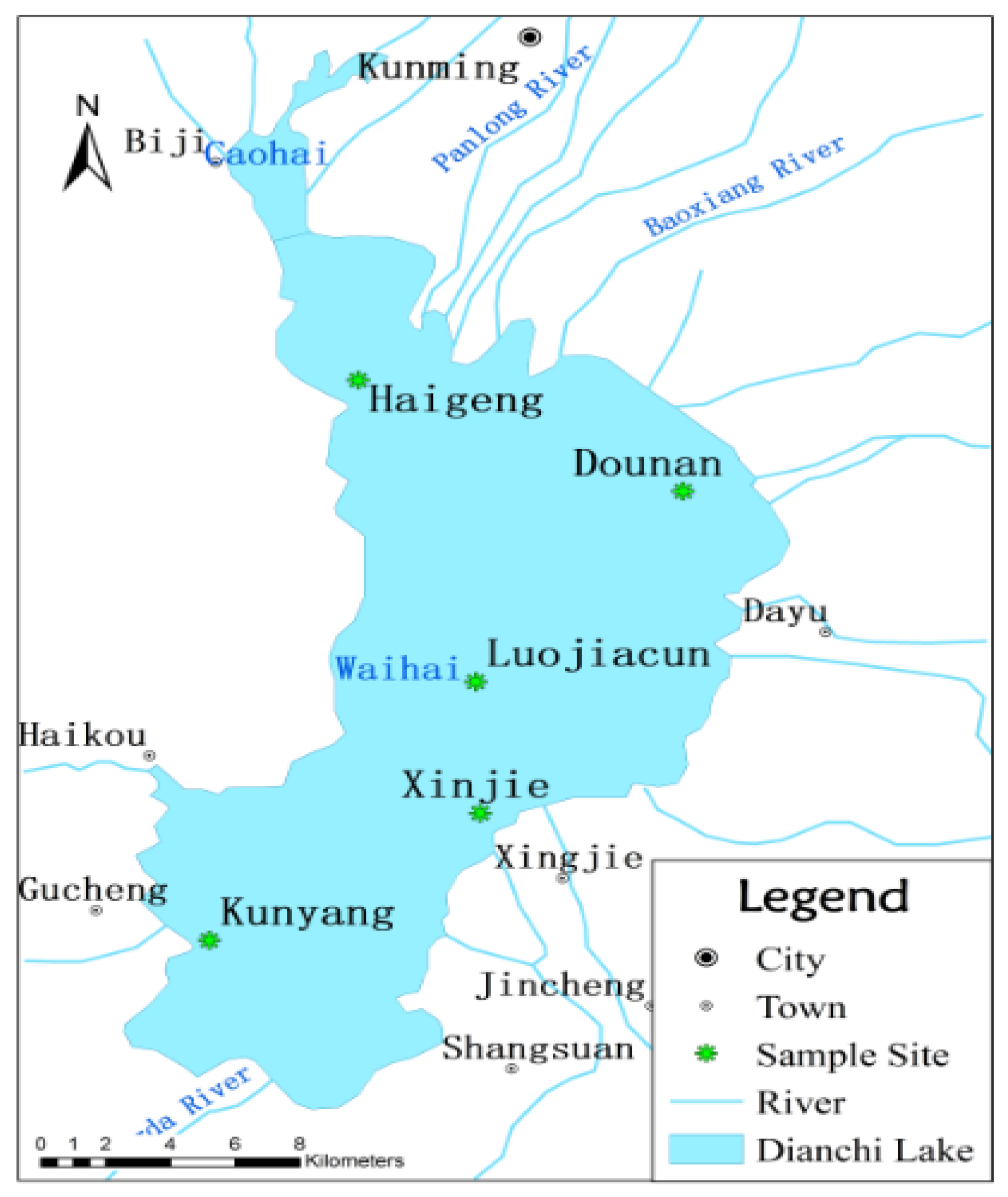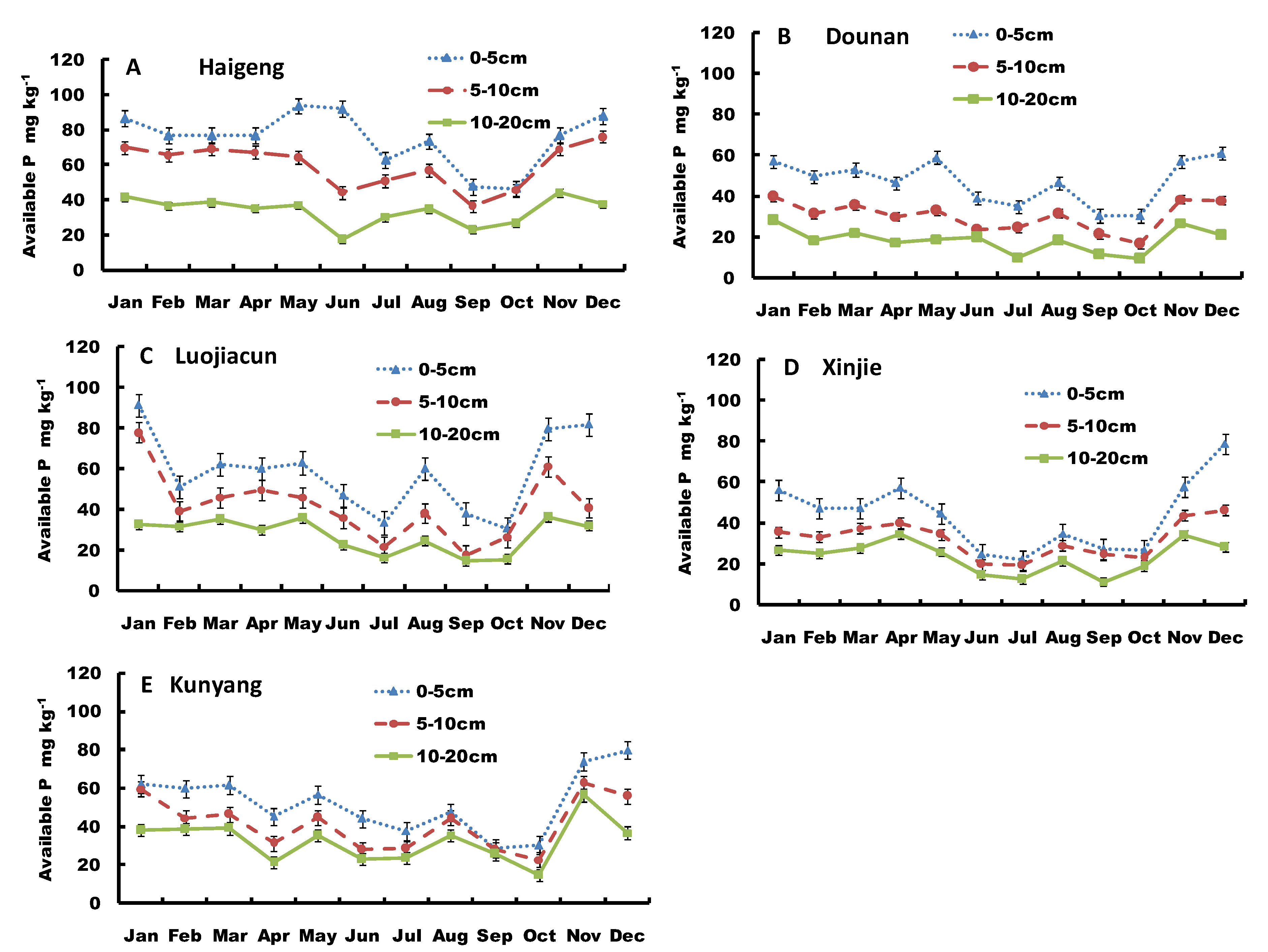Variation in Sediment Available-Phosphorus in Dianchi Lake and Its Impacts on Algal Growth
Abstract
1. Introduction
2. Materials and Methods
2.1. Sites and Sampling
2.2. Determination of Sediment-P, Water-P, and Chlorophyll-a
2.3. Statistical Analysis
3. Results
3.1. Annual Variability in Sediment Available-P and Soluble-P in Dianchi Lake
3.2. Spatial Variability in Sediment Available-P and Soluble-P
3.3. Variation in Sediment Available-P and Soluble-P among Sites
3.3.1. Variation in Sediment Available-P
3.3.2. Variation in Sediment Soluble-P
3.4. Variation in Surface Sediment-P and Water-P at the Sediment–Water Interface in Dianchi Lake
3.4.1. Relationship between Surface Sediment Available-P and Water Total-P
3.4.2. Relationship between Surface Sediment Soluble-P and Water Total-P
3.5. Relationships between Sediment Available-P, Soluble-P, and Chlorophyll-a Concentrations in Dianchi Lake
4. Discussion
4.1. Loading of Available-P and Soluble-P in Sediments of Dianchi Lake
4.2. Temporal and Spatial Variability in Sediment Available-P and Soluble-P in Dianchi Lake
4.3. Sediment Available-P and Soluble-P Exchange at the Sediment–Water Interface
4.4. Effect of Algal Growth on P Releases
5. Conclusions
Author Contributions
Funding
Institutional Review Board Statement
Informed Consent Statement
Data Availability Statement
Conflicts of Interest
References
- Tu, L.Y.; Jarosch, K.A.; Schneider, T.; Grosjean, M. Phosphorus fractions in sediments and their relevance for historical lake eutrophication in the Ponte Tresa basin (Lake Lugano, Switzerland) since 1959. Sci. Total Environ. 2019, 685, 806–817. [Google Scholar] [CrossRef]
- Haggard, B.E.; Scott, J.T.; Patterson, S. Sediment phosphorus flux in an Oklahoma reservoir suggests reconsideration of watershed management planning. Lake Reserv. Manag. 2012, 28, 59–69. [Google Scholar] [CrossRef]
- Kraal, P.; Burton, E.D.; Rose, A.L.; Kocar, B.D.; Lockhart, R.S. Sedimentary iron-phosphorus cycling under contrasting redox conditions in a eutrophic estuary. Chem. Geol. 2015, 392, 19–31. [Google Scholar] [CrossRef]
- Cao, X.Y.; Liu, X.Y.; Zhu, J.M.; Wang, L.S.; Liu, S.M.; Yang, G.P. Characterization of phosphorus sorption on the sediments of Yangtze River Estuary and its adjacent areas. Mar. Pollut. Bull. 2017, 114, 277–284. [Google Scholar] [CrossRef]
- Reinhard, C.T.; Planavsky, N.J.; Gill, B.C.; Ozaki, K.; Robbins, L.J.; Lyons, T.W.; Fischer, W.W.; Wang, C.; Cole, D.B.; Konhauser, K.O. Evolution of the global phosphorus cycle. Nature 2017, 541, 386–389. [Google Scholar] [CrossRef]
- Xu, J. Profiles of Phosphorus Fractions in the Sediments of West Lake, Hangzhou. J. Lake Sci. 2001, 13, 247–254. (In Chinese) [Google Scholar]
- Abrams, M.M.; Jarrell, W.M. Soil-phosphorus as a potential non-point source for elevated stream phosphorus levels. J. Environ. Qual. 1995, 24, 132. [Google Scholar] [CrossRef]
- Wang, H.; Appan, A.; Gulliver, J.S. Modeling of phosphorus dynamics in aquatic sediments: II—Examination of model performance. Water Res. 2003, 37, 3939–3953. [Google Scholar] [CrossRef]
- Xie, L.Q.; Xie, P.; Tang, H.J. Enhancement of dissolved phosphorus release from sediment to lake water by Microcystis blooms—An enclosure experiment in a hyper-eutrophic, subtropical Chinese lake. Environ. Pollut. 2003, 122, 391–399. [Google Scholar] [CrossRef]
- Kowalczewska-Madura, K.; Dondajewska, R.; Gołdyn, R.; Kozak, A.; Messyasz, B. Internal phosphorus loading from the bottom sediments of a dimictic lake during its sustainable restoration. Water Air Soil Pollut. 2018, 229, 1–18. [Google Scholar] [CrossRef]
- Sibbesen, E. An investigation of the anion-exchange resin method for soil phosphate extraction. Plant Soil. 1978, 50, 305–321. [Google Scholar] [CrossRef]
- Zhou, Q.X.; Gibson, C.E.; Zhu, Y.M. Evaluation of phosphorus bioavailability in sediments of three contrasting lakes in China and the UK. Chemosphere 2001, 42, 221–225. [Google Scholar] [CrossRef]
- Jin, X.C.; Tu, Q.Y. Survey Authentication of Lake Eutrophication, 2nd ed.; Chinese Environment Science Press: Beijing, China, 1990; pp. 164–188. (In Chinese) [Google Scholar]
- Huang, X.F. Survey, Observation and Analysis of Lake Ecology; Standard Press of China: Beijing, China, 2000; p. 247. (In Chinese) [Google Scholar]
- Michael, R.P.; Martin, T.A.; Eric, L.V. Phosphorus diagenesis in lake sediments is investigation using fractionation techniques. Mar. Freshw. Res. 1995, 46, 89–99. [Google Scholar]
- Wang, S.R.; Jin, X.C.; Zhao, H.C.; Wu, F.C. Phosphorus fractions and its release in the sediments from the shallow lakes in the middle and lower reaches of Yangtze River area in China. Colloids Surf. 2006, 273, 109–116. [Google Scholar] [CrossRef]
- Kim, L.H.; Choi, E.; Stenstrom, M.K. Sediment characteristics, phosphorus types and phosphorus release rates between rates between river and lake sediments. Chemosphere 2003, 50, 53–61. [Google Scholar] [CrossRef]
- Kim, L.H.; Euiso, C.; Kyung, I.K.; Michael, K.S. Phosphorus release rates from sediments and pollutant characteristics in Han River, Seoul, Korea. Sci. Total Environ. 2004, 321, 115–125. [Google Scholar] [CrossRef]
- Aigaris, J. Seasonal variations in phosphorus species in the surface sediments of the Gulf of Riga, Baltic Sea. Chemosphere 2001, 45, 827–834. [Google Scholar] [CrossRef]
- Muhamed, A.P.; Leela, E.; Meenakumari, B. Studies on the seasonal changes of phosphorus in the marine environments off Cochin. Environ. Int. 2006, 32, 159–164. [Google Scholar]
- Tian, S.P.; Dongye, M.X.; Zhou, J.M.; Zhang, Z. Phosphorus Buren on Water Body of Dianchi Lake and Its Impact on Water Environment. Geol. Chem. Miner. 2002, 24, 11–16. (In Chinese) [Google Scholar]
- Xia, X.H.; Dongye, M.X.; Zhou, J.M.; Zhang, Z.H.; Peng, Y.H. Geochemistry and Influence to Environment of Phosphorus in Modern Sediment in Dianchi Lake. Acta Sedimentol. Sin. 2002, 20, 416–420. (In Chinese) [Google Scholar]
- Gao, L.; Yang, H.; Zhou, J.M.; Chen, J. Sediment burden and release potential of phosphorus to water in Dianchi Lake, China. Acta Sci. Circumstantiae 2004, 24, 776–781. (In Chinese) [Google Scholar]
- Lv, J.J.; Yang, H.; Gao, L.; Yu, T.Y. Spatial Variation of P And N in Water and Sediments of Dianchi Lake, China. Pedosphere 2005, 15, 78–83. [Google Scholar]
- Chen, Y.C.; Tang, L.; Chen, L.; Li, J. Temporally and Spatially Dynamic Variation of Phosphorus in Water of Dianchi Lake. J. Agro-Environ. Sci. 2005, 24, 1145–1151. (In Chinese) [Google Scholar]
- Chen, Y.C.; Tang, L.; Zhang, D.G.; Li, S.M.; Zheng, Y. The Spatially and Temporally Dynamic Variation of Total Phosphorus in Sediment of Dianchi Lake. J. Agro-Environ. Sci. 2007, 26, 51–57. (In Chinese) [Google Scholar]
- Wang, J.H.; Yang, C.; He, L.Q.S.; Dao, G.H.; Du, J.S.; Han, Y.P.; Wu, G.X.; Wu, Q.Y.; Hu, H.Y. Meteorological factors and water quality changes of plateau Lake dianchi in China (1990–2015) and their joint influences on cyanobacterial blooms. Sci. Total Environ. 2019, 665, 406–418. [Google Scholar] [CrossRef]
- Murphy, J.; Riley, J.P. A modified single solution method for the determination of phosphate in natural water. Anal. Chim. Acta 1962, 27, 31–36. [Google Scholar] [CrossRef]
- Reddy, K.R.; Overcash, M.R.; Khaled, R.; Westerman, P.W. Phosphorus adsorption ± desorption characteristics of two soils utilized for disposal of animal wastes. J. Environ. Qual. 1980, 9, 86–92. [Google Scholar] [CrossRef]
- Zhang, N.M.; Yu, Y.; Hong, B.; Chen, J.J. Factors Influencing Phosphorus Loss by Runoff Process from Farmlands in the Dianchi Watershed. Environ. Sci. 2003, 24, 155–157. (In Chinese) [Google Scholar]
- Zhe, Y.M. Eutrophication of Dianchi lake and its trend and treatment. Yunnan Environ. Sci. 2002, 13, 239–248. (In Chinese) [Google Scholar]
- Peng, D.; Jin, F.; Lv, J.J.; Li, R.Y.; Yang, H. Concentration and Distribution of organic matter in Dianchi sediment. Soils 2004, 36, 568–572. (In Chinese) [Google Scholar]
- Zhou, Q. Ecology of Combined Pollution; China Environmental Science Press: Beijing, China, 1995. [Google Scholar]
- Delaney, M.L. Phosphorus accumulation in marine sediments and the oceanic phosphorus cycle. Glob. Biogeochem. Cycles 1998, 12, 563–572. [Google Scholar] [CrossRef]
- Hesse, P.R. (Ed.) A Textbook of Soil Chemical Analysis; John Murray: London, UK, 1971; pp. 255–300. [Google Scholar]
- Hesse, P.R. Phosphorus in Lake Sediments. In Environmental Phosphorus Handbook; Griffith, E.J., Ed.; John Wiley: New York, NY, USA, 1973; pp. 585–611. [Google Scholar]






| Summary Statistic | Surface Layer (0–5 cm) | Middle Layer (5–10 cm) | Bottom Layer (10–20 cm) |
|---|---|---|---|
| Annual average | 55.1 ± 19.3 | 41.1 ± 15.8 | 27.3 ± 9.8 |
| Annual variation | 33.0~77.9 | 25.64~56.6 | 17.1~39.7 |
| Maximum | 93.6 ± 0.8 | 78.0 ± 9.5 | 56.5 ± 1.3 |
| Minimum | 15.1 ± 0.0 | 16.7 ± 2.2 | 9.5 ± 1.4 |
| Variance | 35% | 38% | 36% |
| Summary Statistic | Surface Layer (0–5 cm) | Middle Layer (5–10 cm) | Bottom Layer (10–20 cm) |
|---|---|---|---|
| Annual average | 0.37 ± 0.31 | 0.27 ± 0.28 | 0.17 ± 0.13 |
| Annual variation | 0.10~0.83 | 0.08~0.52 | 0.05~0.29 |
| Maximum | 0.99 ± 0.52 | 0.98 ± 0.26 | 0.48 ± 0.06 |
| Minimum | 0.06 ± 0.00 | 0.02 ± 0.00 | 0.03 ± 0.02 |
| Variance | 83% | 107% | 76% |
| Sediment Layer | Haigeng | Dounan | Luojiacun | Xinjie | Kunyang |
|---|---|---|---|---|---|
| Surface (0–5 cm) | 74.7 ± 12.5 a,α | 47.1 ± 10.9 bc,α | 58.2 ± 19.3 b,α | 43.1 ± 18.4 c,α | 52.3 ± 16.1 bc,α |
| Middle (5–10 cm) | 59.6 ± 12.5 a,β | 30.3 ± 7.4 c,β | 41.7± 16.7 b,β | 32.3 ± 9.1 bc,β | 41.4 ± 13.5 b,αβ |
| Bottom (10–20 cm) | 33.5 ± 7.8 a,γ | 19.8 ± 7.5 c,γ | 27.4 ± 8.2 ab,γ | 23.6 ± 7.8 bc,γ | 32.4 ± 11.2 a,γ |
| Average | 56.0 ± 21.0 | 32.4 ± 14.2 | 42.6 ± 19.7 | 33.0 ± 14.7 | 42.1 ± 15.7 |
| Sediment Layer | Haigeng | Dounan | Luojiacun | Xinjie | Kunyang |
|---|---|---|---|---|---|
| Surface (0–5 cm) | 0.41 ± 0.32 a,α | 0.23 ± 0.16 a,α | 0.41 ± 0.28 a,α | 0.34 ± 0.34 a,α | 0.45 ± 0.39 a,α |
| Middle (5–10 cm) | 0.37 ± 0.36 a,α | 0.13 ± 0.07 b,α | 0.36 ± 0.44 a,α | 0.23 ± 0.19 ab,α | 0.24 ± 0.16 ab,α |
| Bottom (10–20 cm) | 0.19 ± 0.14 ab,α | 0.09 ± 0.07 b,α | 0.18 ± 0.15 ab,α | 0.17 ± 0.12 ab,α | 0.24 ± 0.15 a,α |
| Average | 0.32 ± 0.30 | 0.15 ± 0.12 | 0.32 ± 0.32 | 0.25 ± 0.24 | 0.31 ± 0.27 |
Publisher’s Note: MDPI stays neutral with regard to jurisdictional claims in published maps and institutional affiliations. |
© 2022 by the authors. Licensee MDPI, Basel, Switzerland. This article is an open access article distributed under the terms and conditions of the Creative Commons Attribution (CC BY) license (https://creativecommons.org/licenses/by/4.0/).
Share and Cite
Chen, Y.; Chen, Q.; Zhang, D.; Tang, L. Variation in Sediment Available-Phosphorus in Dianchi Lake and Its Impacts on Algal Growth. Int. J. Environ. Res. Public Health 2022, 19, 14689. https://doi.org/10.3390/ijerph192214689
Chen Y, Chen Q, Zhang D, Tang L. Variation in Sediment Available-Phosphorus in Dianchi Lake and Its Impacts on Algal Growth. International Journal of Environmental Research and Public Health. 2022; 19(22):14689. https://doi.org/10.3390/ijerph192214689
Chicago/Turabian StyleChen, Yongchuan, Qiao Chen, Degang Zhang, and Li Tang. 2022. "Variation in Sediment Available-Phosphorus in Dianchi Lake and Its Impacts on Algal Growth" International Journal of Environmental Research and Public Health 19, no. 22: 14689. https://doi.org/10.3390/ijerph192214689
APA StyleChen, Y., Chen, Q., Zhang, D., & Tang, L. (2022). Variation in Sediment Available-Phosphorus in Dianchi Lake and Its Impacts on Algal Growth. International Journal of Environmental Research and Public Health, 19(22), 14689. https://doi.org/10.3390/ijerph192214689






